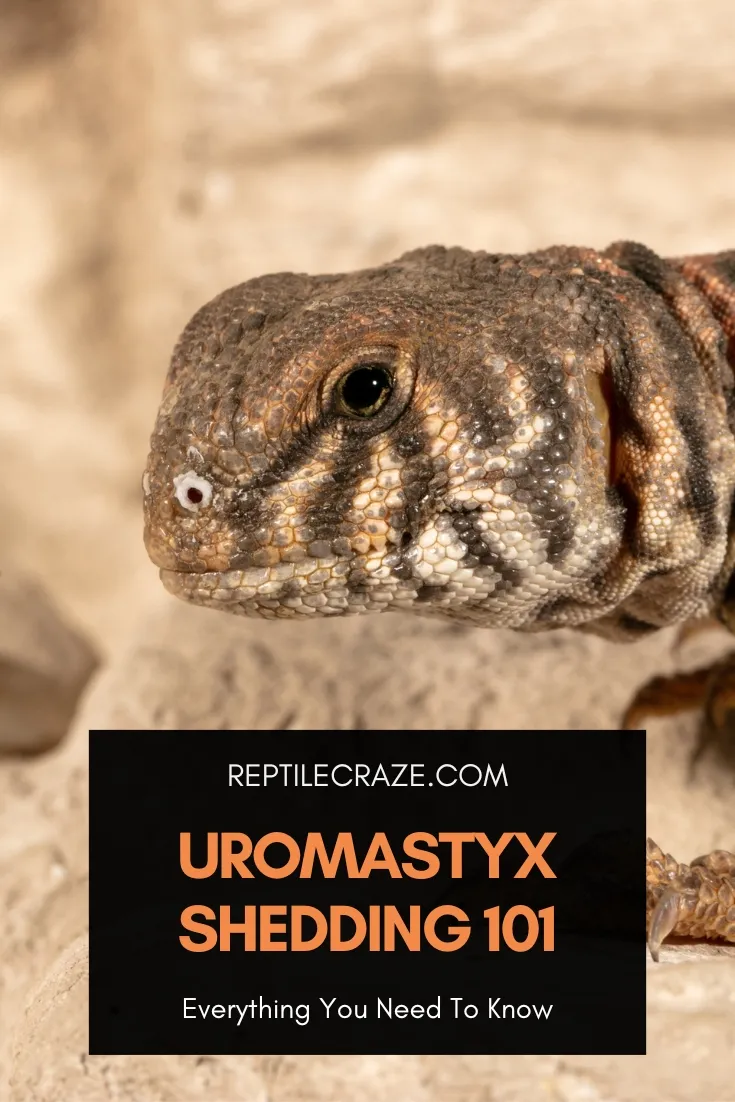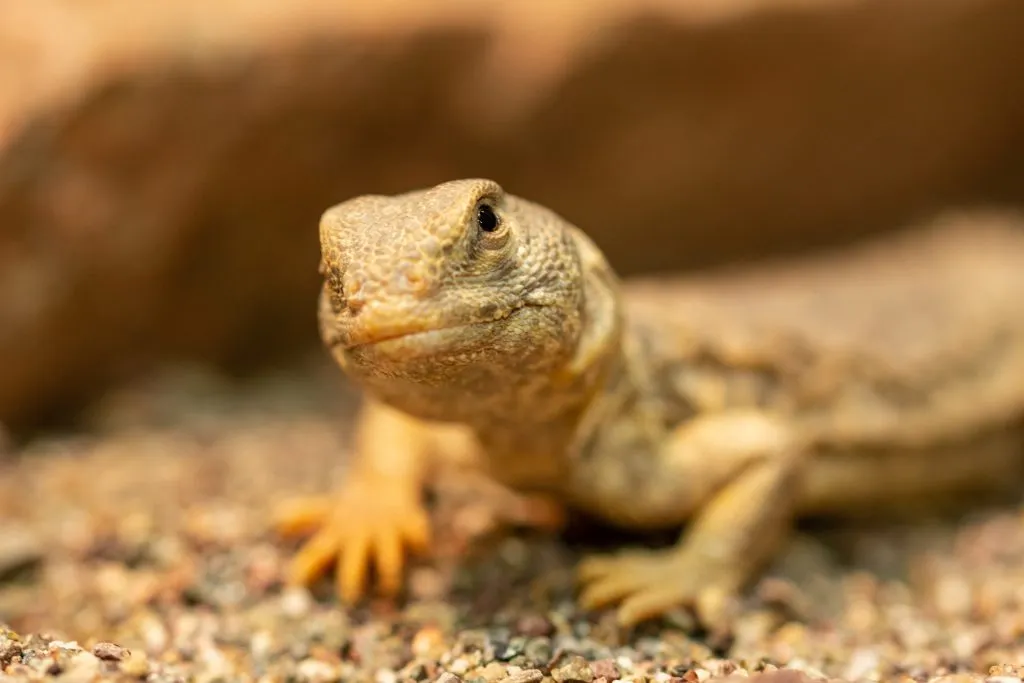
Uromastyx are fascinating reptiles well-known for their distinctive appearance, docile temperament, and interesting behaviors. But as with any pet, it is vital to understand their care requirements, including their natural shedding process.
Shedding is a normal process that uromastyx undergo every few months to replace their old skin. Improper shedding may occur due to issues with environmental temperature, humidity, and overall health. Monitoring your uromastyx to address trouble areas prevents further complications like tail rot.
Reptile owners tend to have a lot of questions about shedding, and this is understandable as we all just want the best for our pets. Here, we have compiled a guide on everything you need to know about Uromastyx shedding.
Table of Contents
Why Do Uromastyx Shed?
All reptiles shed their skin, and uromastyx are no exception. Shedding, scientifically termed ecdysis, is a natural process that allows lizards to grow and replace their old skin at regular intervals.
It also helps them to remove dead or damaged skin and promotes healthy growth.
How Often Do Uromastyx Shed?

Uromastyx shed their skin every few months, but the frequency can vary depending on their age, diet, and environment.
Younger Uromastyx shed more frequently – every 5 to 6 weeks – as they grow more quickly. Adult Uromastyx may shed less often, every 3 to 5 months on average.
How To Tell Your Uromastyx is Shedding?
Ecdysis can be a slow process. Most reptiles take around 14 days to completely shed their skin. During this time, they may exhibit some changes in their appetite and behavior.
Generally, they may become more sensitive and temperamental.
One of the most noticeable signs that your uromastyx is shedding is a change in its skin color. It will appear duller than usual, sometimes slightly grayish.
The eyes may also appear cloudy due to the skin around the eyes becoming more opaque.
Lizards, unlike snakes, shed their skin in pieces. The skin that comes off is mostly transparent. You may see bits and pieces left behind in the enclosure, but note that reptiles tend to eat their shed.
During the shedding process, Uromastyx may also become more inactive than usual. They may spend more time hiding or basking, which can be a sign that they are feeling uncomfortable or vulnerable due to the shedding process.
Why Isn’t Your Uromastyx Shedding?
There are many possible causes behind troubles related to shedding. The most common ones are the following:
- Your uromastyx is not growing enough. Juvenile reptiles do not start shedding until they have grown enough and need to replace their old skin. Uromastyx are generally slow growers, so it may take time before they start shedding, which is normal.
- Your uromastyx is not getting proper nutrition, which may explain why they are not growing well. Certain vitamins and minerals, such as Vitamin A, are vital in skin renewal and growth.
- Low environmental humidity and temperature are the most common factors behind improper shedding.
- A lack of abrasive surfaces in the enclosure. You may see your uromastyx try to rub itself against objects to help with its shedding.
- Wounds and scars make shedding more difficult. Check if your uromastyx has apparent lesions in the skin that may complicate shedding.
- Overhandling can cause dysecdysis. This is a sensitive period for them, so overhandling will induce more stress.
- Your uromastyx has parasites. The most common, snake mites, prevent proper shedding.
- Your uromastyx is sick. It may be dehydrated, have a bacterial or viral infection, other skin issues, or a thyroid problem.
Want to know more about dysecdysis? This book has an entire chapter on improper shedding in reptiles. It’s an excellent read for serious reptile enthusiasts.
Beware of Problems with Uromastyx Tail Shed!

Certain parts of the uromastyx’s body are more prone to improper shedding. These are the extremities such as the digits, tail, and spines.
Uromastyx, in particular, may develop complications in the tail when stuck skin constricts the blood flow.
When blood circulation to the tail is cut off due to improper shedding, uromastyx eventually develop a condition known as tail rot.
The tissue dies, the tail may fall off, and this can lead to further infection. Tail rot can cause death if left untreated.
The Care Guide for Your Shedding Uromastyx
The best way to prevent shedding problems in uromastyx is to provide them with an optimum diet, the proper environmental conditions, and appropriate lighting.
Additionally, monitoring their behavior and appearance can help identify potential problems early on.
Here are some vital points to remember when addressing shedding problems in uromastyx:
- Environmental temperature and humidity should be in an ideal range. The basking area must be 100-115oF (43-6oC). The temperature gradient should be in the 90soF (32-37oC) during the day and 70soF (21-26oC) during the night. Humidity should be within 15-30%.
- Provide nutritional supplements weekly or as recommended by your herp vet. Vitamin A is very important for skin regrowth and renewal. (Get supplements here)
- Provide fresh water daily and spray some water on the leafy greens for feeding. These help prevent dehydration.
- Add substrates or rocks to the enclosure that your uromastyx can rub against to help with shedding. (This is good as well)
- Do not handle your uromastyx during its shedding period.
- Do not aggressively peel back the skin, as this can be painful for your pet. Skin that is ready to be shed will appear clear and flexible, while retained skin will be darker and dry.
- Lightly spray the animal with lukewarm water or this shedding aid solution for small areas of unshed skin. Gently massage the skin or use a wet cotton tip to facilitate gentle skin removal.
- For larger areas of shedding problems, short soaks in shallow water for 10-15 minutes can help soften stubborn skin. Be careful of overdoing this – uromastyx can easily get scale rot or tail rot when their skin is wet for too long!
Of course, if you suspect that your uromastyx has a serious shedding problem, or if there appears to be an underlying health condition causing this, consult your local herp vet for proper diagnosis and treatment.
- Eastern Rat Snake: Nature’s Pest Control and Fascinating Reptile - September 20, 2024
- Eastern Racer: The Fast and Agile Snake - September 19, 2024
- The Eastern Indigo Snake: The Majestic, Non-Venomous Hunter of the Southeast - September 18, 2024
